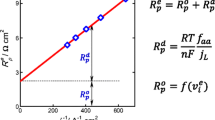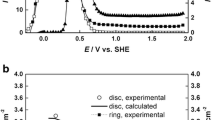Abstract
The effectiveness factor; E f , defined as the fraction of the surface that participates effectively in a given reaction, is an important parameter when operating three-dimensional (3D) electrodes. The rotating disk electrode (RDE) technique with the Fe3+/Fe2+ redox couple as a probe reaction has been used for the evaluation of the effectiveness factor of 3D Ti/IrO2 electrodes with different IrO2 loading. For this purpose, steady-state polarization measurements using Ti/IrO2 rotating disk electrodes in 0.5 M Fe3+/Fe2+ in 1 M HCl were carried out under well-defined hydrodynamic conditions. The low-field approximation relation has been used for the estimation of the exchange current densities j 0, of the Fe3+/Fe2+ redox couple. It was found for this redox couple that the effectiveness factor is very low (<2%) and essentially the 2D electrode surface area works effectively in the steady-state polarization measurements.


Similar content being viewed by others
References
Levenspiel O (1972) Chemical reaction engineering, 2nd edn. Wiley Eastern Limited, New Delhi, p 473
Coeuret F, Hutin D, Gaunand A (1976) J Appl Electrochem 6:417
Savinell RF, Zeller RL, Adams JA (1990) J Electrochem Soc 137:489
Herrera-Calderon E (2008) Effectiveness factor of thin-layer IrO2 electrocatalyst: influence of catalyst loading and electrode kinetics. PhD Thesis, Ecole Polytechnique Fédérale de Lausanne (EPFL), pp 65–67
Bard AJ, Faulkner LR (2001) Electrochemical methods––fundamentals and applications, 2nd edn. Wiley, New York, p 345
Weast RC (ed) (1986) CRC handbook of chemistry and physics, 67th edn. CRC Press, Boca Raton, pp D165–D167
Baticle AM, Perdu F, Vennereau P (1971) Electrochim Acta 16:901
Bard AJ, Faulkner LR (2001) Electrochemical methods–fundamentals and applications, 2nd edn. Wiley, New York, p 106
Acknowledgements
The authors acknowledge the Fonds National Suisse de la Recherche Scientifique for the financial support and Mr. Johnny Nussbaumer for his contribution in the experimental measurements.
Author information
Authors and Affiliations
Corresponding authors
Rights and permissions
About this article
Cite this article
Calderon, E.H., Wüthrich, R., Mandin, P. et al. Estimation of the effectiveness factor of an outer-sphere redox couple (Fe3+/Fe2+) using rotating disk Ti/IrO2 electrodes of different loading. J Appl Electrochem 39, 1379–1384 (2009). https://doi.org/10.1007/s10800-009-9813-6
Received:
Accepted:
Published:
Issue Date:
DOI: https://doi.org/10.1007/s10800-009-9813-6




